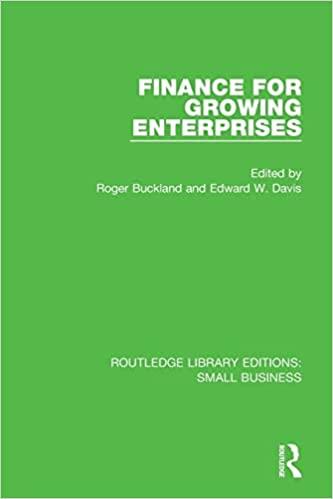Question
Landmark Case: Salomon v Salomon Ltd , [1897] AC 22 (HL) The historical context: When Salomon was decided, the corporationor company, as it is called
Landmark Case: Salomon v Salomon Ltd, [1897] AC 22 (HL)
The historical context: When Salomon was decided, the corporationor company, as it is called in Englandwas just coming into wider usage. At the time, it was unclear whether or not small companies (companies with very few shareholders) would be recognized as a separate legal entity. This was an issue because the British government, in introducing the Companies Act (legislation that granted limited liability to companies), apparently did not intend for it to be used as a way for sole proprietors or partnerships to shelter personal assets by simply incorporating.
Rather, it was seen as a mechanism exclusively for the benefit of larger business organizations. However, there was nothing in the legislation restricting its operation to the more sizeable enterprise. (Source: Paddy Ireland, The triumph of the company legal form, 18561914 in John Adams, ed, Essays for Clive Schmitthoff (Abindgdon: Professional Books Limited, 1983) 29 and Jacob Zeigel et al., Cases and Materials on Partnerships and Canadian Business Corporations, 3rd ed (Scarborough: Carswell, 1994) at 122.)
Factual background: Aron Salomon carried on a profitable shoe manufacturing business for many years as a sole proprietor. He then decided that he wanted to convert his unlimited liability into limited liability. He therefore formed an incorporated companycalled Aron Salomon and Company, Limitedas the vehicle through which to run his business. The Companies Act, which set out the rules for creating a company, required that a company have a minimum of seven shareholders. Therefore, Aron, his wife, his daughter, and his four sons took one share each in the company. Aron became the managing director. Practically speaking, Aron Salomon and Company, Limited was a one-person company since Aron entirely controlled the company. Put another way, the other participants in the company had no involvement in operations: any decision the company made was because Aron wanted to follow that course of action.
| Ownership Structure of Aron Salomon and Company, Limited on date of incorporation | ||||||
| Son 1 | Son 2 | Son 3 | Son 4 | Aron | Arons Wife | Daughter |
| (1 share) | (1 share) | (1 share) | (1 share) | (1 share) managing director | (1 share) | (1 share) |
Next, Aron Salomon and Company, Limited agreed to purchase the assets of Arons sole proprietorship for a sale price of approximately 38 000 pounds (). This price was partially paid by the company issuing to Aron 20 000 shares representing 20 000 of the purchase price. Aron
also received a cash payment of 6000, debentures amounting to 10 000, and a few other benefits. Generally understood, a debenture is a corporate IOU: it is a promise by the company to Aron that it will pay him a specific sum of money. Arons debentures were secured meaning that if the company failed to pay Aron the 10 000, he was automatically entitled to certain company assets in lieu of the cash. In this way, Aron became a creditor of his own company and a highly protected one, at that.
Soon thereafter, the business suffered financial problems because of a series of strikes and the loss of government contracts. The company became insolvent and a trustee was appointed to deal with its creditors and close down the business. Many creditors of Aron Salomon and Company, Limitedincluding Aron himselflined up for payment. As a secured creditor, Aron was at the head of the line but payment of his debt would leave nothing for the unsecured creditors. In response, the trustee refused to recognize Aron as a legitimate creditor and, furthermore, took the position that Aron was personally responsible for all his companys debts.
QUESTIONS
A) Legal questions: Was Aron liable for the debts of Aron Salomon and Company, Limited? Was Aron a legitimate creditor of the company?
B) Discuss the issues and court decision for this case.
Use IRAC (Issue, the Rule of Law, Analysis, and Conclusion) For Analyzing the Legal Process and Your Reasoning
Step by Step Solution
There are 3 Steps involved in it
Step: 1

Get Instant Access to Expert-Tailored Solutions
See step-by-step solutions with expert insights and AI powered tools for academic success
Step: 2

Step: 3

Ace Your Homework with AI
Get the answers you need in no time with our AI-driven, step-by-step assistance
Get Started


